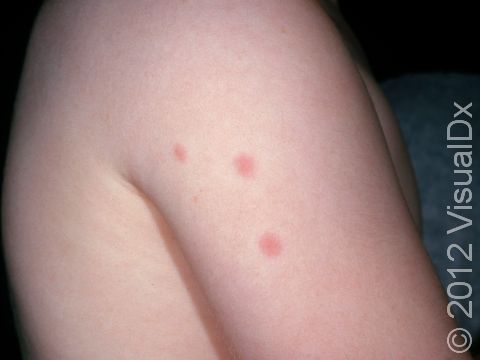Bedbug Bite
Bedbugs are small insects whose food source is the blood of humans and other mammals. Bedbugs tend to live in places such as mattresses, cracks in walls, upholstered furniture, and rugs, and they come out during the night to feed. Their bite is painless, so your baby will likely not wake up when bitten, but the bite produces a very itchy rash. Your baby will wake up with itchy papules (small, solid bumps), usually in lines or clusters. The bite itself is harmless, and bedbugs are not known to spread blood-borne diseases, but babies and children are prone to scratching at bites, potentially causing secondary skin infections.
Who's At Risk?
Anyone of any age can be bitten by bedbugs. Because bedbugs only feed on humans and other warm-blooded animals, they tend to be found in places where there are many people. They are also common in places where travelers pass through, such as hotels and shelters. Because bedbugs do not feed on trash or dirt, there is no association between poor hygiene or untidiness and bedbug infestations. However, babies who sleep in multiple different environments are more prone to bedbugs because they are exposed to multiple potential bedbug habitats.
Signs & Symptoms
You may see a bug bite or notice your child scratching or rubbing their arms or legs against something. The bites appear as papules (small, solid bumps) on the exposed parts of the body (arms, legs, chest, and sometimes the face) that are red in lighter skin colors or deep red, purple, or dark brown in darker skin colors. There is often a clustered configuration of 3 bites in a line (commonly known as “breakfast, lunch, and dinner”). Resolution takes about 2 weeks and can leave some darker areas of skin (postinflammatory hyperpigmentation).
Infants who are prone to eczema may develop a large, bumpy rash that is red or darker than the surrounding skin. They area is often severely itchy, putting the baby at risk for bacterial infection if scratching causes breaks in the skin.
Signs of bedbug infestation include blood stains on the sheets or flecks of bedbug dung on or around the bed, or a sweet odor that results from large numbers of bedbugs. You may be able to spot a moving bedbug if you search at night.
Self-Care Guidelines
Management of bedbug bites includes removing the bedbugs themselves and controlling the child’s itching.
Wash all linens in hot water, and dry the bedding in a hot dryer. You may also need to wash the curtains. Scrub furniture to remove eggs, and fix any cracks in the furniture. Vacuum the room, including the mattress (concentrating on the seams) and any surrounding crevices. You may want to fill and seal any cracks around the room and paste down any rolling wallpaper seams. Check the adjoining rooms for bedbugs as well, even if the occupants do not complain of itching.
It is best to have a licensed pest control agent inspect and eradicate the bedbugs. Note that some insect repellants can be toxic to children, so make sure to find out exactly what chemicals the agent will be using and what the risks are.
A low-strength topical corticosteroid cream or ointment, such as hydrocortisone, can be purchased over the counter to help with itching. It should not be applied to the face or in skin folds. Make sure to keep the baby’s nails trimmed short to prevent creating breaks in the skin from scratching.
Treatments
Your baby’s medical professional may prescribe a topical corticosteroid to help reduce the itching and inflammation. These are especially helpful at night to help prevent scratching and infection. In rare cases of blistering skin reaction, oral corticosteroids may be necessary. If your baby has a bacterial infection of the skin from scratching, they may need oral antibiotics. Rarely, anaphylaxis has occurred and is treated with emergency care.
Visit Urgency
Your baby may need a prescription-strength topical steroid to help intensely itchy bites. Infants have an especially hard time refraining from scratching, especially at night, and will attempt to rub the affected area on anything nearby. Consult with your baby’s medical professional before trying an antihistamine such as diphenhydramine (eg, Benadryl). Because scratching can lead to infection, if there is pus, redness, swelling, fever, or if the reaction blisters or is otherwise severe, call your baby’s medical professional. There have been rare cases of severe allergic reaction that affect breathing (anaphylaxis). If this is the case with your baby, seek emergency medical care.
References
Bolognia J, Schaffer JV, Cerroni L. Dermatology. 4th ed. Philadelphia, PA: Elsevier; 2018.
James WD, Elston D, Treat JR, Rosenbach MA. Andrew’s Diseases of the Skin. 13th ed. Philadelphia, PA: Elsevier; 2019.
Kang S, Amagai M, Bruckner AL, et al. Fitzpatrick’s Dermatology. 9th ed. New York, NY: McGraw-Hill Education; 2019.
Paller A, Mancini A. Paller and Mancini: Hurwitz Clinical Pediatric Dermatology. 6th ed. St. Louis, MO: Elsevier; 2022.
Last modified on June 14th, 2024 at 11:18 am

Not sure what to look for?
Try our new Rash and Skin Condition Finder

